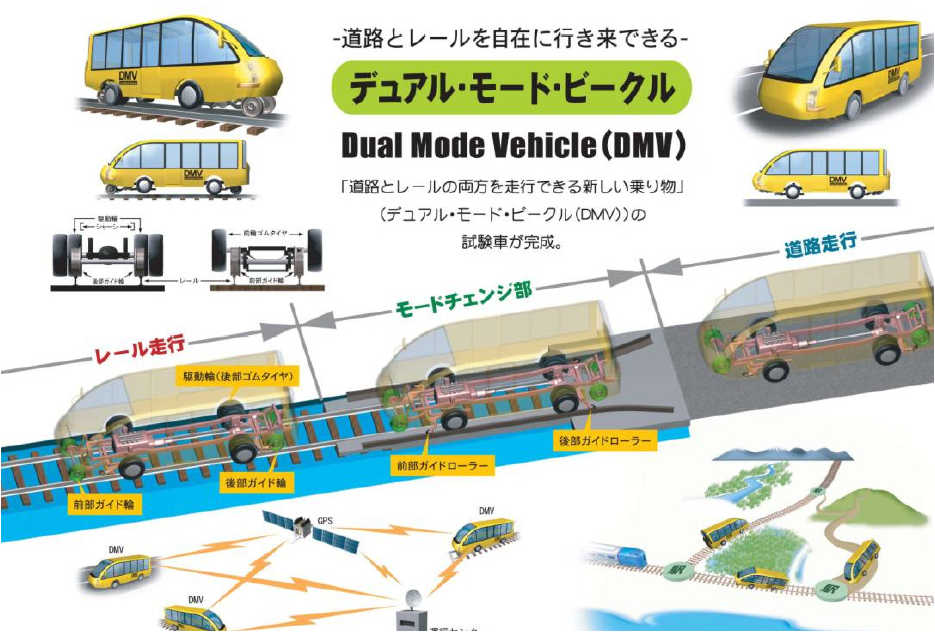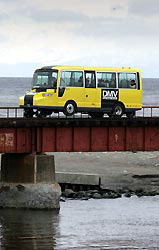
Japanese Dualmode Vehicle

The vehicle has been developed by the JR Hokkaido Railway Company. A prototype minibus has been built which has retractable train wheels for use on conventional railway tracks. Estimates were that these vehicles would be available for use in 2006. The first test run with 12 passengers was conduced in April 2007. It is currently estimated that it will cost approximately 15,000,000 yen or about $145,000 at December, 2004 exchange rates (= 103 yen/$). The prototype was developed from a JR Hokkaido project that was started in 2000. The 28-seat minibus has four highway wheels for roads and four steel wheels plus two rubber tires for tracks. It can be switched from rail to highway in 10-15 seconds and can be operated on the highway at 60 kph. Further testing with passengers will be continued through the end of June, 2007.

See a video showing the initial trial runs with passengers
Below is a summary of a translation of a 2005 report (in Japanese) from the JR Hokkaido Railway Company
There have seen many attempts to develop a vehicle that can run on roadways and rails throughout the world but none has succeeded. JR Hokkaido has been working to implement this dual mode concept.
About a third of JR Hokkaido's rail lines carry less than 500 passengers per day, which are not productive.
Many attempts have been made to reduce the cost of those lines, and they have been implemented. Increased ridership cannot be expected under the current conditions.
Non-traditional ideas have been explored to further reduce the cost and make the services more attractive.
A Dual Mode Vehicle has been developed as a part of the Dual Mode Transport System, which also includes the Mode Interchange System and the Operation Management System.
The first attempt to develop a dual mode system was made by LMS Railway in England in 1932. During the pre-World War II era, Germany, Japan and Australia attempted to develop such a system, but they could not bring the concept to implementation for regular operation. The major reasons were that they took too much time to change from one mode to another, and that it was too costly to develop the system.
There have been basically two types of dual mode vehicles. One is to replace the power drive tires with the rail wheels when running on rails, and the other is to use the same rubber tires on both rails and roads.
The use of the rubber tires for the power drive on the road and rail had one advantage: the time to change mode can be designed to be much less. But, the disadvantage is that the life of the rubber tires is too short. In addition, the security of the vehicles became an important issue.
The test DMV (901) is a bus on the roads and a hybrid of bus and rail on rails. At the mode interchange from the road mode to the rail mode, horizontal guide rollers are extended, the rail wheels at the front and back are lowered. When this is completed, the front tires are pulled up.
In order to prolong the use of the power drive rubber tires, it was determined that the ratio of the weight on the rear power drive tires and the steel guide wheels should be 60 percent on the tires vs. 40 percent on the guide steel wheels.
There are other design features to assure safe operation for this vehicle.
The concept of the dual mode vehicle should be viewed as a new technology for use in the urban transport network, although the development of this technology was aimed at improving rural transportation service while reducing cost.
A new operational prototype has been prepared. The goal is to deploy the DMV operation in one of the rural lines in Hokkaido within sometime in 2007.
For a similar version of this dualmode concept, called Blade Runner, being developed in the U.K., see http://faculty.washington.edu/jbs/itrans/bladerunner1.htm
Last modified: April 29, 2007